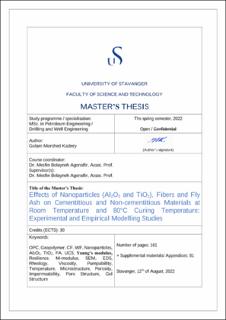| dc.description.abstract | Cement constitutes undoubtedly one of the most important well barrier elements, in terms of maintaining well integrity by preventing undesired flow of reservoir fluid into the wellbore. NORSOK D-010 standard dictates that well cement must be impermeable, non-shrinking, ductile and resistant to corrosion among other requirements to ensure long term integrity of the wells [1]. Although, various surveys have found that conventional well cement have serious shortcomings that are the reasons for compromising well integrity globally. It was discovered in 2003 that 8000 to 11000 wells in GOM experienced SCP due to compromised cement integrity as the ages of the wells increased [2]. In 2008, cement failure induced well integrity issues were detected in around 10.7% of 75 NCS wells from a total of 406 well that were included in this study [3]–[4]. Poor cement qualities affect the environment as well. Reported in 2013, authorities in Pennsylvania had issued notices of environmental violations to 1144 wells out of 3533 wells, where 8.7% violations originated from poor cement and casing quality that led to environmental pollution [5]. These investigations reveal that cement in its neat form fails to maintain permanent zonal isolation in wells. It goes without saying, the current cement properties do not meet the regulatory requirements. This is why investigations were conducted to improve the mechanical and rheological properties.
Applications of nanotechnology have spread over numerous industries. Numbers of research publications concerning the implementations of nanotechnology are ever growing with time and some studies have shown to have obtained promising results using different metallic nanoparticles. Consequently, Al2O3 and TiO2 nanoparticles (NPs) were considered to be investigated in conjunction with G-class Ordinary Portland Cement (OPC), fly ash (FA), geopolymer cement, carbon fibers (CF) and white glass fibers (WF). Moreover, two different curing environments of room temperature of 20°C and oven temperature of 80°C were introduced to study the temperature effects on the nano-modified cementitious and non-cementitious materials. Because the conventional cement gets degraded when exposed to high temperature for a long time. In terms of experimental structures, total of five test designs were constructed. Four test designs were made with OPC had curing ages of 3, 7 and 28 days and they were cured in both room and oven. One design consisting of geopolymer cement were mainly cured in room temperature for a period of 10 days.
Lower concentration of Al2O3 NPs seemed to improve the uniaxial compressive strength (UCS) of OPC by 100.1% in room and 24.8% in oven after 28 days of curing. OPC modified with solitary FA and binary hybrid of FA and intermediate Al2O3 had shown improvement in early strength after 3 and 7 days. However, after 28 days, solitary and binary blend of FA showed opposing results. Medium concentration of TiO2 NPs significantly improved the UCS of geopolymer cement by 41.8%. When applied in OPC, lowest dosage of TiO2 improved the strength of OPC plug by 19.2% in room temperature after 28 days, whereas the highest concentration performed the best in oven with 42.1% UCS raise. With an intention to potentially reducing cement’s brittleness, CF and WF were added with TiO2 as respective binary hybrids to OPC, which had presented with very optimistic results. Generally, TiO2 with highest dosage of CF had shown the most improvements in OPC strength developments in both curing environments. The stiffness, energy absorption capacity and modulus of elasticity of the samples were also analysed, however there were no clear trends of the developments of these properties. Rheological properties for the additives-modified OPC slurries were determined to have workability and slurries were comparatively pumpable, whilst nano-added geopolymer cement was highly viscous for the given LSR. The internal structures of nano-added OPC and geopolymer plugs were analysed with SEM. An empirical UCS vs compressional wave velocity (vp) model was developed from the experimental data from this thesis and it was subsequently tested with three other models to verify its competence and was found to be quite fitting. | |
